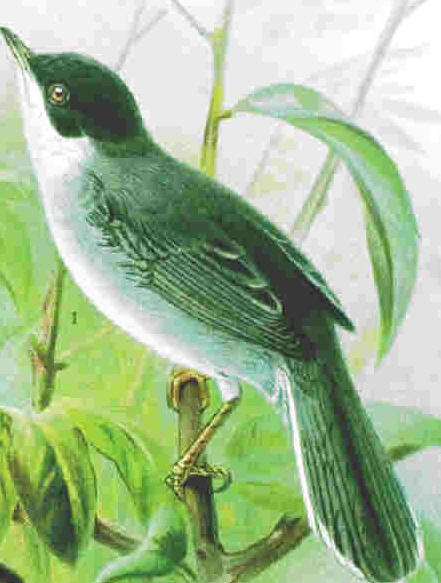- Sardinian Warbler
Taxobox
name = Sardinian Warbler

image_width = 220px
image_caption = Adult male
status = LC
status_system = iucn3.1
regnum =Animal ia
phylum =Chordata
classis =Aves
ordo =Passeriformes
familia =Sylviidae
genus = "Sylvia"
species = "S. melanocephala"
binomial = "Sylvia melanocephala"
binomial_authority = (Gmelin,1789 [Type locality: "Sardinia "] )
subdivision_ranks =Subspecies
subdivision =2-6, see textThe Sardinian Warbler, "Sylvia melanocephala", is a common and widespread
typical warbler from theMediterranean region.Description
Like most "Sylvia"
species , it has distinct male and femaleplumage s. The adult male has a grey back, whitish underparts, black head, white throat and red eyes. Plumages are somewhat variable even in the same locality, with the intensity of a reddish hue on upper- and/or underside varies from absent to (in somesubspecies ) pronounced. The female is mainly brown above and buff below, with a grey head.The Sardinian Warbler's song is fast and rattling, and is very characteristic of the
Mediterranean areas where this bird breeds.Distribution and ecology
It breeds in the southernmost areas of
Europe and just intoAsia in Turkey and the eastern end of the Mediterranean. This smallpasserine bird , unlike most "warbler s", is not particularly migratory, but some birds winter in northAfrica , and it occurs as a vagrant well away from the breeding range, as far asGreat Britain .This is a
bird of open country and cultivation, with bushes for nesting. The nest is built in low shrub or brambles, and 3-6 eggs are laid. Like most "warbler s", it isinsectivorous , but will also take berries and other softfruit .ystematics
Together with
Menetries' Warbler it forms asuperspecies . Both thave whitemalar areas and light throats, and otherwise black theads in adult males, as well as a naked ring around the eye. TheSubalpine Warbler , which seems the superspecies' closest relative, has a dark throat and breast and a dark gray upper head in males, but otherwise shares these characters. These three species are related to a dark-throated superspecies consisting ofRüppell's Warbler and theCyprus Warbler , which also share the white malar area with blackish above. [Helbig (2001), Jønsson & Fjeldså (2006)]This bird may be considered a
superspecies , divided into the western "Sylvia melanocephala" and "Sylvia momus" from the more arid regions of theNear East and adjacent Africa.ubspecies
The geographical variation in the Sardinian Warbler conforms to some extent with
Gloger's Rule , though not as strongly as in some other typical warblers. The validity of "leucogastra" and "norissae" is not accepted by some authors, and "valverdei" has been described very recently. On the other hand, "leucogastra" might be more than one subspecies.Cabot & Urdiales (2005)]* "Sylvia melanocephala melanocephala" (Gmelin, 1789):Iberia across the northern
Mediterranean to westernTurkey . Extends into theMaghreb from Iberia, and intoLibya fromItaly viaSicily . Migrates to theSahel andoases in the Sahara in winter. :Large, long wings, tail tip rather pointed. A dark form, usually lacking any reddish in males but flanks extensively grey. Females' uppersides vary between deep olive brown and greyish olive.
* "Sylvia melanocephala leucogastra" (Ledru, 1810) - often included in "melanocephala";phylogenetic status requires review:Canary Islands , resident, probably some vagrancy between eastern islands and Maghreb.:Medium size, short-winged and large-billed.Tenerife andLa Palma (western) birds are most distinct, being dark above with some rusty/beige hue on the underside in males. Eastern birds (Fuerteventura ,Lanzarote andGran Canaria ) are more like "melanocephala" and "momus" but differ in measurements.
* "Sylvia melanocephala momus" (Hemprich & Ehrenberg, 1833):Near East . Resident, some local movements.:Smallish, short-winged. Varies between brownish grey and rusty above; underside almost always has reddish hue. Females rusty to rusty olive.
* "Sylvia melanocephala norissae" Nicoll, 1917: Fayyum Warbler - probably only a local morph of "momus":Nile Delta region.Extinct since around 1940.:Like "momus", but tend to be very reddish.
* "Sylvia melanocephala valverdei" Cabot & Urdiales, 2005 - recently split from "melanocephala":FromTiznit (Morocco ) south to theTropic of Cancer , inland to the edge of theSahara . Resident, but some seasonal movements.:Medium-sized, tail tip quite square. A very pure-colored form, the palest subspecies. Undersides clean white. Matte black cap in males. Juveniles decidedly sandy.Footnotes
References
*|year=2004|id=52835|title=Sylvia melanocephala|downloaded=12 May 2006 Database entry includes justification for why this species is of least concern
* (2005): The subspecific status of Sardinian Warblers "Sylvia melanocephala" in the Canary Islands with the description of a new subspecies from Western Sahara. "Bull. B.O.C." 125(3): 165-175.
* (2001): Phylogeny and biogeography of the genus "Sylvia". "In:" Shirihai, Hadoram: "Sylvia warblers": 24-29. Princeton University Press, Princeton, N.J.. ISBN 0691088330
* (2006): A phylogenetic supertree of oscine passerine birds (Aves: Passeri). "Zool. Scripta" 35(2): 149–186. doi|:10.1111/j.1463-6409.2006.00221.x (HTML abstract)External links
* [http://www.ibercajalav.net/img/368_SardinianWarblerSmelanocephala.pdf Ageing and sexing (PDF) by Javier Blasco-Zumeta]
* [http://www.bsc-eoc.org/avibase/species.jsp?lang=EN&id=195397EB3BB4F5A8&ts=1221659690354&sec=summary Avibase]
Wikimedia Foundation. 2010.
